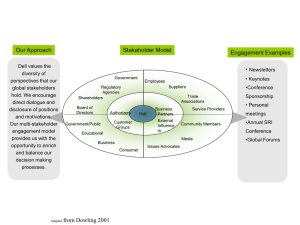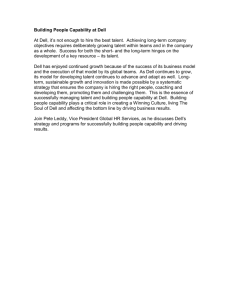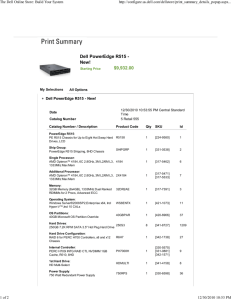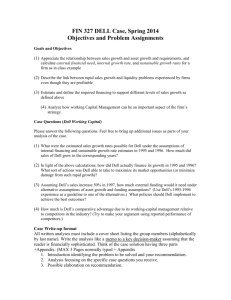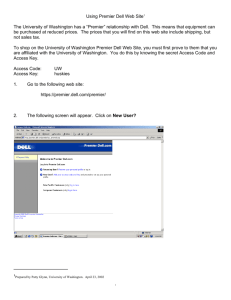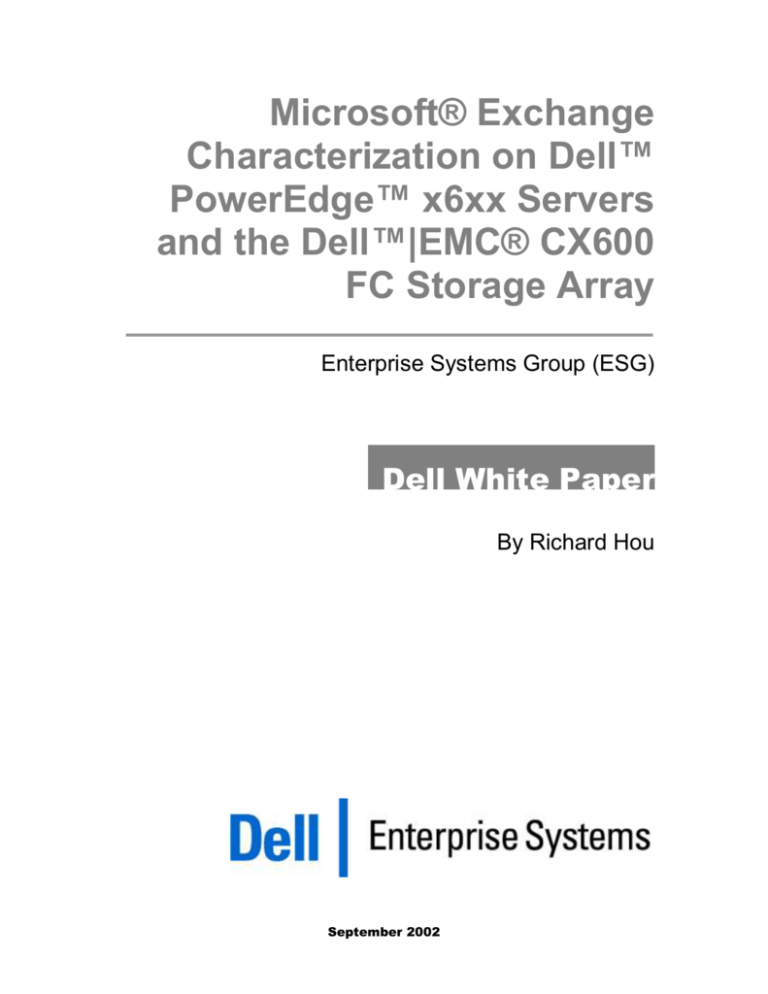
Microsoft® Exchange
Characterization on Dell™
PowerEdge™ x6xx Servers
and the Dell™|EMC® CX600
FC Storage Array
Enterprise Systems Group (ESG)
Dell White Paper
By Richard Hou
September 2002
Contents
Executive Summary .................................................................................................................................... 4
Introduction ................................................................................................................................................. 5
Microsoft Exchange 2000 Architecture .............................................................................................. 7
Dell/EMC Fibre Channel Products for Storage Area Networks ................................................... 7
Test Methodology ....................................................................................................................................... 9
Hardware and Software ....................................................................................................................... 9
Exchange On PowerEdge x6xx Servers ..................................................................................................15
Host Side Memory Tuning ................................................................................................................15
Data File Tuning ..................................................................................................................................16
Optimize Transaction Log .........................................................................................................16
Optimize Storage Group ............................................................................................................17
Optimize Database File ..............................................................................................................17
RAID level and Stripe size .................................................................................................................20
Which Server to Use ............................................................................................................................22
Other Performance factors .................................................................................................................24
Conclusion ..................................................................................................................................................26
Contacts .................................................................................................................................................26
Appendix A: Reference Documents ......................................................................................................28
Figures
Figure 1: Design flow for Exchange Environment .................................................................................. 5
Figure 2: Exchange 2000 Server Configuration ......................................................................................12
Figure 3: PowerPath Manager Console ...................................................................................................13
Figure 4: Memory Configuration on the CX600 Storage Processor .....................................................18
Figure 5: 73GB 10K rpm Drive Throughput ...........................................................................................19
Figure 6: CX600 Latency Performance Based on Number of Users .....................................................19
Figure 7: RAID5 Enhancements on the Dell/EMCCX600 ......................................................................21
Figure 8: Response time on RAID10 and RAID5 ...................................................................................21
September 2002
Page 2
Dell Enterprise Systems Group
Figure 9: Response Time on different Stripe size ...................................................................................22
Figure 10: LoadSim Score for the PowerEdge 6650 and PowerEdge 2650..........................................23
Figure 11: PowerEdge 6650 versus 2650: CPU Load and Number of Users .......................................23
Figure 12: The Speed and Topology of the HBA card ...........................................................................24
Figure 13: Load Balancing Policy with PowerPath ................................................................................25
Tables
Table 1: Configurations of the Test Exchange Servers...........................................................................10
Table 2: Feature Comparison Between the Dell/EMC FC4700-2 and the CX600 ...............................11
Table 3: ATF and PowerPath Feature Comparison ...............................................................................13
September 2002
Page 3
Dell Enterprise Systems Group
Section
1
Executive Summary
This paper provides a set of data for analyzing the performance of the Dell™
PowerEdge™ 6650 and PowerEdge 2650 servers running Microsoft® Exchange
2000 Server with the new Dell|EMC® CX600 Fibre Channel RAID storage array.
Also, this paper reviews the data to provide guidelines for Exchange deployment
from the perspective of storage consolidation and server consolidation. By
analyzing the structures of the CX600 storage array and the Exchange 2000
database, key factors affecting design and performance of the Exchange storage
backend are discussed. These considerations and suggestions can help to achieve
a more efficient storage IO environment.
September 2002
Page 4
Dell Enterprise Systems Group
Section
2
Introduction
The advent of new technology continuously expands the possibilities for better
solutions. The goal of this trend is not only to increase efficiency and return-oninvestment (ROI), but also to achieve better performance. Since Microsoft
released Exchange 2000, it has become very popular because of its reliability and
efficiency in providing a critical messaging service for the growing needs of user
information/ collaboration. But because of the business critical nature of this
application, designing and deploying an Exchange environment requires
considerable planning. This includes everything from Active Directory design to
disk group configuration. Figure 1 shows a typical flow chart for designing an
Exchange environment. Every factor that theoretically affects the environment
should be studied prior to initiating the production environment.
Environment
Survey
Setup Testing
Pilot
Move to
Production
Environment
Data Analysis
Pilot Testing
Monitoring
Performance
Design Plan
Data Analysis
Future Upgrade
or
implementation
Testing Plan
Review
Design Phase
Staging Phase
Production Phase
Improve Phase
Figure 1: Design flow for Exchange Environment
This paper focuses on the storage design and characterization of Exchange 2000
on Dell newly released PowerEdge 6650 and PowerEdge 2650 servers and
September 2002
Page 5
Dell Enterprise Systems Group
DELL/EMC CX600 Storage Area Network (SAN) IO subsystem. To plan the
storage strategy for Microsoft® Exchange 2000, four criteria usually apply:
capacity, availability, performance, and recovery. Different environments have
different priorities, so for each of these criteria, it is important to apply the flow
chart and make sure the deployment will meet the requirements of the
messaging environment. The criteria significantly affect the cost, architecture,
maintenance, and disaster recovery of the Exchange 2000 environment.
Capacity is typically the easiest of the criteria to start with. The Exchange 2000
database includes three parts (discussed in detail in “Running an Optimized
Microsoft Exchange 2000 Server with Dell|EMC SAN” at
http://www.dell.com/us/en/esg/topics/power_ps2q02-hourun.htm): a private
database for information store, a public database for public folders, and a
transaction log for log files. The total storage requirement for capacity is:
Capacity = Information Store + Public Store + Transaction Log
The size of the information store varies from organization to organization. The
total size is typically equal to the number of users times the size of the mailbox
for each user. Capacity will significantly affect disaster recovery time (discussed
in the Dell paper “Backup and Restore of Microsoft Exchange 2000 Using Dell|EMC
SAN” at http://www.dell.com/us/en/esg/topics/power_ps2q02-houback.htm).
Every organization has a different SLA (Service Level Agreement). The SLA
defines the level of availability required by the organization, and even how the
requirements may differ from site to site. The messaging environment may be
categorized as mission critical, business critical, regular, or non-essential…
although the last is rare due to the heavy dependency on messaging systems of
modern organizations. Availability can be achieved at different levels. On the OS
level, clustering can provide application/CPU redundancy for an Exchange
environment. On the I/O level, RAID (Redundant Array of Independent Disks)
and Dell/EMC’s no-single-point-of-failure environment help ensure there is
always a redundant path to access data. Availability can affect the cost of the
implementation and increase the complexity of the environment, so it must be
planned for carefully.
Performance is a very broad topic. It can affect the environment at all levels, from
the OS to a single disk in an array. A detailed profile of the current environment
will be a great help to understand the implementation of the future solution. For
this paper, the focus is on the throughput of the disk backend. Most companies
profile their environment by I/Os per user per second. Reflected at the backend,
this is equivalent to how many transfers (total reads and writes) the ID system
handles every second.
Recovery is another important metric in the SLA. A company without a recovery
plan is like a company with no messaging system. Without a fallback plan, the
damage may be greater than for an organization that has never used an
Exchange environment. Recovery time is closely related to the size of the
information store. By carefully distributing the mailbox to multiple databases, it
is possible to greatly reduce the backup/restore time.
September 2002
Page 6
Dell Enterprise Systems Group
Dell has partnered with Microsoft for over 15 years. This relationship has helped
the two companies join together to provide integrated solutions with high
availability, reliability, scalability, and high performance. Microsoft Exchange
2000 on Dell PowerEdge Servers and Dell/EMC Storage Area Network (SAN)
products not only offers redundancy, but also provides excellent
price/performance for small, medium and enterprise customers. This paper
discusses the issues mentioned above and presents best practices for configuring
Dell servers and storage for Exchange 2000.
Although the focus of this paper is on Information Store on a stand-alone server,
the best practices also apply to cluster and public folders.
Microsoft Exchange 2000 Architecture
With significantly enhanced features and newly developed functions, Microsoft
Exchange 2000 is a major revision of Exchange 5.5. Architecturally, Exchange
2000 does not use a self-contained messaging system like Exchange 5.5. Exchange
2000 separates many components and tightly integrates them with the
underlying Windows® 2000 operating system and Microsoft Internet
Information Server (IIS). These improvements are designed to reduce the
overhead on the Exchange servers, enable consolidation of the users onto many
fewer servers, and unify the network and messaging administration, all of which
can help contribute to lower total cost of ownership (TCO). An article in the
Power Solutions Journal Issue 3, 2001 discussed the new architecture. In
summary, the key features of Exchange 2000 that bring scalability, reliability and
availability include:
Active Directory integration
Multiple message database support
Reliable SMTP support
Active/Active Clustering Support
Dell/EMC Fibre Channel Products for Storage Area Networks
Dell’s Storage Area Networks (SANs) use fibre channel and RAID (redundant
array of independent disks) technologies to provide the data protection, speed,
flexibility, and storage capacity necessary to meet the performance requirements
of complex server networks. EMC developed its first full fibre channel storage
solution in 1997. By partnering with EMC, Dell’s fibre channel storage
subsystems can support large or small data storage networks. Dell provides endto-end enterprise solutions including software, hardware and service, as well as
a single point of contact and the ability to upgrade to future products and
features to help protect customer investments.
September 2002
Page 7
Dell Enterprise Systems Group
SANs provide an excellent means for storage consolidation. Multiple servers
(hosts) with different operating systems can share the same backend fabric on a
different network environment that can help remove traffic from an Ethernet
LAN, resulting in better network throughput. Currently the fibre channel
standard – FC2 – delivers up to 200 megabytes per second (MB/sec) of
bandwidth for half-duplex configurations, and up to 400 MB/sec for full-duplex
configurations.
Dell SANs also provide a high availability environment through the use of
redundant paths from the front-end servers that share the storage equipment to
the redundant switches in between the storage subsystem(s) and the servers.
This architecture helps ensure I/O access if one component fails. Battery backup
is used to increase the integrity of data written to the RAID controller caches.
Dell/EMC products also provide the horsepower to drive I/O performance. The
recently released Dell/EMC CX600 is a completely new enterprise storage
product, appropriate for enterprise users looking to implement modular storage.
For a shared environment or an application that is I/O intensive, the CX600 has
two 2 GHz Pentium® processors on each storage processor. This configuration is
designed to deliver optimal I/O performance. With the Dell/EMC CX600, up to
240 disks are supported by adding Disk Assembly Enclosures (DAEs), which
house only drives. These features help make this Dell/EMC solution a great
choice for large organizations looking to consolidate and centralize storage with
modular systems that can grow along with user needs.
September 2002
Page 8
Dell Enterprise Systems Group
Section
3
Test Methodology
The goal of testing was to determine the best and most economical configuration
for an environment, and understand how many users can be supported on both
the servers and the backend storage. The test Dell developed simulated an
environment with multiple users accessing the server simultaneously to stress
the Exchange server. The I/O activities were then logged and analyzed to
understand Exchange IO patterns. To simulate the user workload, the Microsoft
Messaging Benchmark 2 (MMB2) specification was used to create the user
database and Microsoft’s LoadSim program was used to generate messaging
requests. Information stores for 500 to 5,000 users were created on RAID10 and
RAID5 arrays with different parameters.
Hardware and Software
The focus of the test was to identify the best configuration for the backend I/O
system, and determine how to eliminate factors that negatively impact the
performance prior to reaching the configuration backend. For a 5,000-user test,
the Active Directory Service was likely to be very busy. To eliminate the
potential bottleneck, Active Directory (AD) was installed on a PowerEdge 6450
as the Domain Controller (DC). The AD database and log file were put on
different physical drives than the operation system. The PowerEdge 6450 was
also used as the performance monitoring system while fourteen Optiplex™
GX110s were used to create multiple virtual users for different scenarios. For
validation, one Optiplex was configured with 20 users as a control system. This
was designed to compare the results of the control system with the rest of the
clients in order to determine how many users will create bottleneck and stress
the server.
Two servers, a PowerEdge 6650 and a PowerEdge 2650, were used as the
Exchange 2000 servers. Both servers use Intel® Xeon™ processors. The
PowerEdge 6650 Exchange server was configured with four Intel Xeon 1.6GHz
CPUs and 4GB memory, while the PowerEdge 2650 had two Intel Xeon 2.4GHz
processors with 4GB memory. Table 1 shows the configurations of the test
servers.
Note: The primary differences between the dual (DP) and quad (MP) Xeon processors
are in the clock speed and on-die cache. Currently, the DP Xeon processors support up to
512KB L2 cache, with clock speeds that range from 1.8 to 2.4GHz. The MP Xeon
processors not only support 256KB L2 cache, but also up to 1MB L3 cache, with clock
September 2002
Page 9
Dell Enterprise Systems Group
speeds of 1.4, 1.5 and 1.6GHz. Because of greater cache support, the MP processors
generally perform and scale better than DP processors, and are used on mid-range to
high-end servers.
PowerEdge 2650
PowerEdge 6650
Processor/Cache
Dual 2.4GHz Xeon DP, 512KB L2
Cache
Quad 1.6GHz Xeon MP, 256K of L2
and 1MB L3 cache
Front Side Bus (FSB)
400 MHz FSB
400 MHz FSB
Chipset
ServerWorks GC-LE
ServerWorks GC-HE
Memory
4GB SDRAM (can be configured up
to 6GB)
4 GB SDRAM (can be configured up
to 16GB)
SCSI
Integrated dual channel Ultra3
(Ultra160)
Integrated single channel Ultra3
(Ultra160)
RAID
Embedded PERC 3/DI w/128MB
cache (optional feature)
Hot Plug PCI/PCI-X Slots
3 PCI-X (1X64/133, 2X64/100)
7 PCI-X; 1 PCI (7x64/100,1x32/33)
Hot Plug Hard Disk Drives
5 X 73GB hot plug
5 X 73GB hot plug
NICs
Embedded Gigabit NICs1
Dual embedded Broadcom Gigabit
Network Interface Cards
Remote Management
Embedded Remote Access (ERA)
Table 1: Configurations of the Test Exchange Servers
Another major processor improvement is Hyper-Threading. By efficiently
splitting the use of on-die registers, Hyper-Threading allows a single CPU to act
like two, which benefits applications that are not licensed by the number of
CPUs. But since there is only one path to high-speed cache memory and one
connection to the rest of the computer, performance isn't the same as with a true
dual-processor server. The Dell System Performance Analysis (SPA) team
conducted a test on a PowerEdge 6650 with Hyper-Threading both on and off,
and the performance gain with it on was about 20 percent. Even so, this
technology helps improve the performance of the PowerEdge 6650 and
PowerEdge 2650. With this under consideration, tests were run on both
platforms to understand if the PowerEdge2650 can be used for entry and middle
level Exchange environments, which could help reduce the cost of hardware.
1
This term indicates compliance with IEEE standard 802.3ab for Gigabit Ethernet, and does not
connote actual operating speed of 1 Gb/sec. For high speed transmission, connection to a Gigabit
Ethernet server and network infrastructure is required."
September 2002
Page 10
Dell Enterprise Systems Group
A Dell/EMC CX600 SPE and two CX600 DAEs were used as the fibre channel
storage subsystem. The CX600 is a new product that extends the Dell/EMC Fibre
Channel offering into a higher performance market. Table 2 shows the difference
between FC4700-2 and the CX600.
FC4700-2
Cx600
4 direct attached servers
8 direct attached servers
Up to 64 servers in a SAN
Up to 128 servers in a SAN
Up to 21.7TB / 120 Disks
18,36,73,181Gb 1.6-inch drives
Up to 17.5TB / 240 Disks
36,73Gb 1-inchdrives
360MB/Sec
1,100MB/Sec
50,000 IOPS
140,000 IOPS
RAID 0, 1, 1/0, 3, 5
RAID 0, 1, 1/0, 3, 5
Maximum 2GB Cache
Maximum 8GB Cache
Multipath I/O
Multipath I/O
Non Disruptive Upgrade
Non Disruptive Upgrade
Snapshots and FC mirroring
Snapshots and FC mirroring
4 X 2Gb front-end, 4 X 1Gb back-end
8 X 2Gb front-end, 4 X 2Gb back-end
Table 2: Feature Comparison Between the Dell/EMC FC4700-2 and the CX600
Unlike the FC4700-2 Disk Processor Enclosure (DPE) with 10 drives inside, the
CX600 Storage Processor Enclosure (SPE) does not have any drives inside. All
DAE enclosures were populated with fifteen FC2 interface disks, with each using
only 3U of rack space. For storage subsystem connectivity, the Exchange server
had two Emulex 9002 Host Bus Adapters (HBAs). Two Dell/EMC DS-16B2
switches were used to create a switched fabric.
Figure 2 shows the complete configuration tested, with fully redundant paths for
high availability.
September 2002
Page 11
Dell Enterprise Systems Group
Workload generator
TCP/IP Network (LAN)
Exchange Server
Management
Station
SAN
Storage System
DC
CX600
Fibre Channel
Network
Network Management
Connection
Figure 2: Exchange 2000 Server Configuration
Note from Table 2 that the CX600 has four FC2 back-end and eight FC2 front-end
connections. These can significantly widen the pipe for the data movement. The
CX600 uses the same means as the FC4700-2 for connections between the
processor enclosure and the disk enclosures. Please refer to the SAN deployment
poster for a diagram of how this is done:
http://www.dell.com/us/en/esg/topics/power_ps2q02-poster.htm.
Other differences between the CX600 and FC4700-2 are on the software side.
Disk management can be managed through a web browser. The UI (User
Interface) is run on array to provide downloadable Java applets for the front
interface. Backend storage I/O systems can also be configured in different
domains for ease of management as in an Ethernet environment. Management
station can be any system with JRE 1.3.1.01 and above installed. For security, the
web-based management interface is using both HTTP and HTTPS for connection.
Three kinds of users can be created: administrator, manager, and monitor. The
latter only has read access.
On the host side, PowerPath™ has replaced Application Transparent Failover
(ATF) software. PowerPath automatically manages multiple paths between host
and LUN. Unlike ATF, which is only for failover, PowerPath supports failover
and load balancing, as well as restore. In a multiple path environment, if one
path fails, the I/O is automatically load balanced through the rest of the path, and
September 2002
Page 12
Dell Enterprise Systems Group
restored to the previous operation after the failure has been fixed. Table 3 shows
the differences between the two applications.
Feature
ATF
PowerPath
Connectivity
Up to 4 paths
Up to 16 paths
Fail Over & Recovery
Automatic Fail Over, Manual
Recovery
Automatic Fail Over and Recovery
Load Balancing
Static & Round Robin
Round Robin, Least I/O’s, Least Blocks,
Dell/EMC Optimized
Host/Array types
W2K, NT, AIX, Solaris, with Dell/
EMC arrays
W2K, NT, AIX, Solaris, Unix & Linux with
Dell /EMC & Symmetrix arrays
Table 3: ATF and PowerPath Feature Comparison
Figure 3 shows the multiple paths to the LUN with PowerPath.
Figure 3: PowerPath Manager Console
To ensure that the server itself is not the bottleneck, best practices from previous
testing still apply:
September 2002
Ensure that the server has sufficient memory, fast disk drives, and a fast
network adapter(s).
Page 13
Dell Enterprise Systems Group
Run Exchange server as a member server, not a domain controller, to reduce
the traffic to the memory and disks.
Run the Exchange server and domain controller or Global Catalog Server on
the same network.
Install Microsoft Windows 2000 Advanced Server and Exchange 2000 on
RAID 1 internal drives.
Reconfigure the Page file to be on a different physical drive than the
operating system.
Change the server mode to “Optimized for Server Application.”
Enable the /3GB switch from the boot.ini file when using 4GB memory or
more.
The last bullet is also called 4GT tuning. By default, the Windows 2000 kernel
will allocate 2GB memory, even though most of the time the usage is under 1GB.
4GT tuning forces the OS to allow user mode processes to use the upper 3GB of
RAM.
It is also important to create a monitoring plan to continuously monitor the
environment. The performance of the environment is not the same all the time,
especially when new factors are introduced into the scenario.
Also see the following URL for additional information about deploying
Exchange:
http://www.microsoft.com/exchange/default.asp
September 2002
Page 14
Dell Enterprise Systems Group
Section
4
Exchange On PowerEdge x6xx Servers
As mentioned in Section 2, four factors affect Exchange 2000 Server’s database
implementation: capacity, redundancy, performance, and recovery. Although it
is possible to use the capacity formula on Page 5 to determine how much storage
space is necessary, this only establishes the minimum storage requirement.
Capacity is different than server sizing. Sizing is about how many mailbox users
are supported per server. Although one server might support enough storage
space, other resources may limit the number of users on it. Differences in the
SLA of different databases can result in the requirement to put them in different
storage groups. Understanding capacity combined with performance data will
determine the right number of servers for a given environment.
Host Side Memory Tuning
Of all the factors that affect the supported number of users on the host side, the
most important one is memory. In order to operate at peak efficiency, sufficient
physical RAM must be installed to prevent page file swapping to disk. Also, it is
critical that the STORE.EXE process does not run out of virtual memory. If this
happens, memory allocation fails and the Information Service will not respond to
requests. Under normal operating conditions, half of the total memory installed
is reserved for the OS, leaving half of the memory available for applications. This
is unnecessary since the OS is not using nearly that much memory. When the
4GT tuning is enabled, it reserves 3GB of virtual RAM (instead of 2GB) for
applications and 1 GB of virtual RAM is left for the OS and pagefile. With 4GB of
physical RAM installed and the use of the /3GB switch, the majority of virtual
memory resides in physical RAM.
Under the assumption that the maximum virtual memory for the Store.exe is
2.8GB for a standalone server, the OS usually uses about 128MB of this memory,
and the server usually reserves 150MB for each storage group created. A typical
user requires 300KB memory. If the Exchange server has only one storage group,
then the maximum number running on a server can be:
(2.8GB – 128MB -150MB)/300KB = 8,800 users
This means that even if the backend storage is enough, the server still cannot
support more users unless each user is using less than 300KB of memory. For
best practices, putting all databases into one storage group is not a good plan.
When it is time to perform an online data backup, databases inside the same
storage group can only be done serially, compared with databases from different
September 2002
Page 15
Dell Enterprise Systems Group
storage groups where the backup can be executed in parallel. When more storage
groups are created, the number of supported users drops because more memory
is reserved for the groups. The advantage of using multiple storage groups with
the database is that the system can efficiently recover the user database because it
has been split into manageable sizes. And because it is divided into storage
groups, the database can be put on different Logic Units (LUN) that offer more
disk spindles (for better disk performance) as well as the transaction log file for
each different storage group.
Data File Tuning
Optimize Transaction Log
Transaction logs are important, as they are key to the recovery of the Exchange
database. Because it is 100 percent sequential write and I/O intensive, write
operations should be optimized. For a small user environment (a few hundred
users) the effect of the transaction log is not significant. But for large user
environment, optimization of the transaction log file can bring performance
gains. Here are some best practices on how to optimize the transaction log:
Use a dedicated LUN for transaction log files.
Do not put multiple transaction log files on the same LUN. Even if they are
all sequential, multiple sequentials can actually create a random
environment.
Enable the write-through mode (disable write cache) on the LUN.
Use RAID1 or RAID10 for the log file. This is because the transaction log is
100 percent write. Dell used RAID1 for the transaction logs for all tests.
Make sure the backup power source is functioning normally. This is very
important. As with the FC4700, the CX600 comes with two SPSs (standby
power sources) for the storage processors. In a power failure, the SPS will
flush all data in the cache to the drive to ensure no data is lost. Lack of
backup power can cause data loss or file corruption because the most recent
changes have not yet been committed to the database. Storage Processor
cache is also protected by mirroring write cache between two processors.
On Exchange 5.5, the circular log is enabled by default. Although this can
save the log space, it is not recommended for recovery of log files. Make sure
the circular log is disabled to enable data discovery. Also, monitor the
environment to assure the capacity for log files is large enough between full
backups.
Inside the event viewer, change the Application and System event properties
to “Overwrite events as needed.” Otherwise, if the event log is full, it will
stop the service.
September 2002
Page 16
Dell Enterprise Systems Group
Optimize Storage Group
Multiple storage groups are essential for server consolidation. When Exchange
backs up the data, it will back up from the storage group level, so multiple
groups can create multiple parallel backup processes. And, when doing the
restore, it can be on database level within the storage group. Thus users can be
categorized into different databases, i.e., by name, by SLA or by business
functionality. Since backup windows have been reduced, more users can be put
on one server than use the common backend storage device for storage
consolidation.
Optimize Database File
Different than the transaction logs that live on the storage group level, database
files live inside the storage group and are defined at data-store level. The I/O
pattern for the Exchange database (random reads and writes with about a 21:9
ratio) is different than that of the transaction log. Database files are critical since
they are the repositories of all messages. Factors like size, RAID type, stripe size
and memory usage can affect the performance and backup/restore time. Because
of the random access pattern, the system doesn’t need a lot of read cache. As long
as there is enough space for pre-fetching, the rest of the memory should be
assigned to write cache to improve the performance. The CX600 algorithms that
both read and write cache will be also be used for the read I/O. This is very
efficient, since most of the read I/Os tend to read the most recent data, and the
write cache usually holds the most recent data. The CX600 supports a total of
8GB of onboard memory. For this test, Dell used 50MB for read cache and
assigned 2048MB for write cache (although theoretically up to 4GB can be used
for write cache , since Dell was running a beta core software, it was only possible
to assign 2048MB to the write cache. The official release will fix this). Figure 4
shows the configuration window for SP cache.
September 2002
Page 17
Dell Enterprise Systems Group
Figure 4: Memory Configuration on the CX600 Storage Processor
Another factor to consider is the database for key users in the organization.
Usually these users need fast recovery time, so they should be put into a
relatively small database. On the other hand, they should not all be put within
one database, so that in the case of a database failure, not all of these users will
lose their email.
The number of drives inside the RAID group not only determines the available
capacity, but is also an important factor for performance. The number of users
and the mailbox sizes determine the required capacity. Then the number should
be compared to the spindle number derived from I/O performance of the drives.
Administrators should have an idea of the typical I/O workload for their
environment (i.e., IOPS for the Exchange environment), and use the following
formula to determine the total I/O requirements for the backend IO system:
Total I/O = IOPS/user X number of Users
The total I/O is divided by I/Os that each spindle handles, which should equal
the number of working spindles in the RAID group. In addition, different drives
have different performance rates. For the CX600 in this test, default drives inside
were 73GB 10K rpm drives. By using the Intel IOMeter, Dell determined the
typical throughput for each drive, as shown in Figure 5.
September 2002
Page 18
Dell Enterprise Systems Group
250
73GB 10K
IOPS
200
150
100
50
0
2K IO
4K IO
8K IO
Access IO
Figure 5: 73GB 10K rpm Drive Throughput
The result of running LoadSim to simulate Exchange users on a PowerEdge 6650
is close to a production environment. For the test, Dell used a 5 spindle RAID5
with a 32KB stripe size. Dell derived this configuration from previous tests as a
good starting configuration. (The results of testing with a different stripe size are
shown in the next section.)
As shown in Figure 6, the latency is acceptable until the load exceeds 3,000 users.
Response time starts to change exponentially. This is quite different, and an
improvement, compared with the results from FC4700, where 5 drive RAID5
only supported up to 2,000 users. This is due to new features on the CX600
including large cache support, true FC2 interface on the hard drive, and more
room in the drive memory for buffering.
0.18
0.16
Latency (sec)
0.14
0.12
0.1
0.08
0.06
0.04
0.02
0
500
750
1000
1250
2250
2500
3000
3750
User Number
Figure 6: CX600 Latency Performance Based on Number of Users
September 2002
Page 19
Dell Enterprise Systems Group
A LoadSim score is a statistic that is 95 percent focused on response time. It
averages the data collected from different actions: send, receive, schedule, public
folder, etc.; and creates a more user centric view. Figure 7 shows the LoadSim
score on the test. The graph shows that at a load above 3,000 users, the response
time for a front-end user will go above a half second and become unacceptable.
10000
LoadSim Score (95%,msec)
9000
8000
7000
6000
5000
4000
3000
2000
1000
0
500
750
1000
1250
2250
2500
3000
3750
User Number
Figure 7: LoadSim Test Score
RAID level and Stripe size
Storage consolidation is not a good idea unless the data at the backend can be
protected and highly available. At the disk group level, Dell uses RAID for data
protection. Both RAID 5 and RAID 10 provide data protection, but come with
different costs and benefits. For the same amount of disks, RAID 5 provides more
space than RAID10. Both RAID5 and RAID10 have the same read performance,
but on write I/O, traditionally RAID10 out-performs RAID5 because RAID5
needs to read the old data and parity data from the drive, re-calculate the new
parity, then write new data and parity to the disk. This is called the “RAID5
penalty” since it uses the extra I/O for parity calculation. This has been changed
in the CX600. Coalescing is used inside the cache, so that instead of writing all
data to the drive, the storage controller makes sure that the data can fit in the
stripe line, and then writes the data and parity at the same time. Figure 8 shows
the flow of this mechanism.
September 2002
Page 20
Dell Enterprise Systems Group
Figure 8: RAID5 Enhancements on the Dell/EMCCX600
Modified RAID5 runs like RAID3, so it is very efficient for large block I/O
operations. Exchange typically does 5 to 6K I/O blocks, so this implementation is
not very efficient since I/Os will be flushed to the drive before the stripe line can
be filled, thus old data and parity information still need to be read in first. Dell
tests show the difference between a 3,000-user test on a 5-spindle RAID5 and on
a 10-spindle RAID10. On performance, RAID10 still performs better but RAID5 is
more economical.
350
300
LoadSim Score
250
200
150
100
50
0
RAID5
RAID10
Figure 9: Response time on RAID10 and RAID5
Stripe size is another factor that can be tuned after the RAID level is decided.
Although Dell’s previous test and papers show that a 32K stripe out performs the
default 64KB stripe, on the CX600 this was not true. Figure 9 shows the test
results. The test was of 3,000 simulated users driven by Microsoft LoadSim
software on the same 5-spindle RAID5 group. When binding the LUN there is an
option for element size, which defaults to 128. The default of a 128 element size
equals a 64KB stripe size because on Dell|EMC storage an element is 512 bytes.
September 2002
Page 21
Dell Enterprise Systems Group
This means that the element size must be divided by two to reach the size in KB,
because it takes two 512-byte elements to equal 1 KB. Test results show that
Keeping the Default for Exchange environment offers the best results.
0.07
Latency (sec)
0.06
0.05
0.04
0.03
0.02
0.01
0
16K RAID5
32K RAID5
64K RAID5
Figure 10: Response Time on different Stripe sizes
Which Server to Use
Is it necessary to use the most powerful server in an Exchange environment? The
answer is no, for several reasons. First, Exchange is not a CPU-intensive
application. If the front-end server is highly utilized, there will already be a
bottleneck somewhere else: memory, network or backend I/O subsystem.
Second, Hyper-Threading significantly improves two-way system performance.
Third, the speed increases of CPUs are significant. A less powerful system today
can handle a greater workload than a “powerful” system from just a few years
ago. Finally, storage I/O subsystems have greatly improved in capability. The
main reason to use a SAN is for storage consolidation. Since Exchange is not a
CPU hog, if the backend can handle the traffic, then the front-end server should
not be a big concern. With this in mind, Dell also tested a Dell PowerEdge 2650 at
a 3,000-user level versus the PowerEdge 6650. Figure 10 shows that the results
are very close.
September 2002
Page 22
Dell Enterprise Systems Group
370
LoadSim Score (msec)
360
350
340
330
320
310
300
290
280
PE6650
PE2650
Figure 11: LoadSim Score for the PowerEdge 6650 and PowerEdge 2650
Dell used one more test to compare the two systems. For this test, the focus was
on the CPU utilization of both of the systems. The results show that for the
PowerEdge 2650, CPU utilization and number of users are linear. This means
that for more than 5,000 users, an organization should use the PowerEdge 6650
instead of the PowerEdge2650, since it is best practice to always leave a 25
percent margin on the server CPU. This makes PowerEdge 2650 a very attractive
candidate for small- to middle-sized Exchange environments, especially based on
cost. For the Enterprise-level environment, the PowerEdge 6650 is a better choice
for both scalability and performance.
70
PE6650
CPU Utilization (%)
60
PE2650
50
40
30
20
10
0
2000
3000
4000
5000
Figure 12: PowerEdge 6650 versus 2650: CPU Load and Number of Users
Note that the users shown here are not running in one single RAID5 group. For
the above data, four RAID5 groups were used within one storage group.
September 2002
Page 23
Dell Enterprise Systems Group
Other Performance factors
There are other factors that can affect performance. On the I/O pipeline, any
component can create a performance bottleneck. The following are
recommendations from EMC and lessons learned from previous tests completed
at Dell.
Figure 13: The Speed and Topology of the HBA card
First, ensure that the host bus adapters (HBAs) are taking advantage of FC2. As
shown in Figure 12 (based on an Emulex controller), make sure each part of the
topology runs at 2Gb speed, and that the right topology is selected. This will help
optimize the communication between devices.
The second parameter to check is through the PowerPath application. PowerPath
has different ways to distribute I/Os through different paths. It is important to
consider and choose the appropriate path for the environment. Figure 13 shows
the configuration window.
September 2002
Page 24
Dell Enterprise Systems Group
Figure 14: Load Balancing Policy with PowerPath
And, finally, if possible, dedicate a LUN for each database, and spread the
databases across different storage groups. This helps reduce overhead on the
same RAID group, and increase backup/restore efficiency while the system is
online. Also, use a dedicated LUN for the transaction log. Since the Transaction
Log is pure write, use RAID1 or RAID10 instead of RAID5.
September 2002
Page 25
Dell Enterprise Systems Group
Section
5
Conclusion
The tests that Dell conducted simulating a Microsoft Exchange environment have
shown that Dell’s PowerEdge 2650 and PowerEdge 6650 servers are both great
candidates for an Exchange server. The PowerEdge 2650 is an excellent choice for
a small to mid-sized environment, while the PowerEdge 6650 is good for midsized to enterprise organizations. The DELL/EMC CX600 provides enough
power to drive the storage backend with more enhanced features than its
predecessors, and Exchange 2000 Server takes full advantage of the high
availability and scalability of the CX600. With the new database design, more
users can use a single server, which helps reduce the number of servers needed.
With the right design, configuration, and continuous monitoring, Dell servers
and storage products can be combined with Microsoft Exchange 2000 to create a
robust messaging environment.
Contacts
For questions about this paper or the implementation of Microsoft Exchange
Server 2000 with Dell products, please contact a Dell sales representative. For
comments and feedback about this paper, please send email to
us_technology_showcase@Dell.com.
Solution Enablement Lab and Showcase
Enterprise Systems Group/Storage Systems Group
Dell Computer Corporation
One Dell Way
Round Rock, Texas USA 78682
+1-(800) WWW-DELL (999-3355)
or +1-(512) 338-4400
us_technology_showcase@Dell.com
www.dell.com
THIS WHITE PAPER IS FOR INFORMATIONAL PURPOSES ONLY, AND MAY CONTAIN
TYPOGRAPHICAL ERRORS AND TECHNICAL INACCURACIES. THE CONTENT IS PROVIDED
AS IS, WITHOUT EXPRESS OR IMPLIED WARRANTIES OF ANY KIND.
September 2002
Page 26
Dell Enterprise Systems Group
Dell, PowerEdge, and PowerVault are trademarks of Dell Computer Corporation. EMC is a
registered trademark of EMC Corporation. Microsoft and Windows are registered trademarks of
Microsoft Corporation. Intel is a registered trademark and Xeon is a trademark of Intel Corporation.
Other trademarks and trade names may be used in this document to refer to either the entities
claiming the marks and names or their products. Dell disclaims proprietary interest in the marks and
names of others.
©Copyright 2002 Dell Computer Corporation. All rights reserved. Reproduction in any manner
whatsoever without the express written permission of Dell is strictly forbidden. For more
information, contact Dell. Dell cannot be responsible for errors in typography or photography.
Information in this document is subject to change without notice.
September 2002
Page 27
Dell Enterprise Systems Group
Section
7
Appendix A: Reference Documents
1.
Microsoft Exchange Web Site: http://www.microsoft.com/exchange
2.
Dell online: http://www.dell.com
3.
Microsoft Exchange 2000 Server Administrator’s Pocket Consultant, William
R. Stanek, Microsoft Press, 2000
4.
Exchange 2000 Server Black Book, Marcus Goncalves, The Coriolis Group,
LLC, 2002
5.
Exchange 2000 Resource Kit, Microsoft Press, 2002
6.
Tuning and Sizing Windows 2000, Curt Aubley, Prentice Hall PTR, 2001
(date)
7.
Running Microsoft Exchange 2000 on Dell SAN 4.0, Richard Hou, Power
Solution, Issue 3, 2001
8.
Running an Optimized Microsoft Exchange 2000 server with Dell|EMC SAN,
Richard Hou, Power Solution, May 2002
9.
Exchange 2000 on EMC Symmetrix: A guide to Best Practices, EMC white
paper, March 2002
10. The EMC CLARiiON Data Integrity Difference, EMC white paper, May 2001
September 2002
Page 28
Dell Enterprise Systems Group

